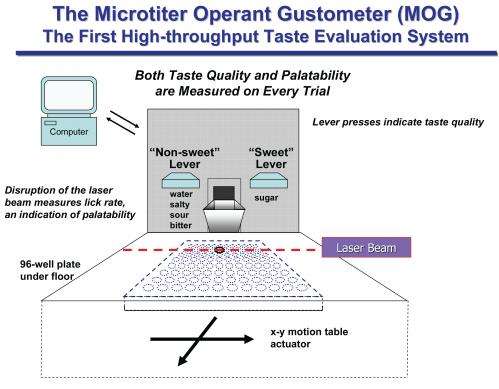Researchers develop method for high-throughput taste evaluation

Scientists at Opertech Bio, Inc. have developed a proprietary apparatus and methodology for high-throughput taste evaluation. The work points to approaches that have the potential to greatly improve the process for discovering new flavor ingredients, measuring palatability and optimizing flavor formulations. The findings appear in the August 12, 2013 issue of the peer-reviewed journal PLOS ONE.
The research paper, entitled, "A High Throughput In Vivo Assay For Taste Quality and Palatability," was authored by members of Opertech's discovery research team and former colleagues, including R. Kyle Palmer, Daniel L. Long, Francis X. Brennan, Tulu Buber, Robert W. Bryant, and F. Raymond Salemme. The complete manuscript is available online at http://dx.plos.org/10.1371/journal.pone.0072391.
The manuscript describes the Microtiter Operant Gustometer, or MOG, a high throughput system for measuring both taste quality (what does a sample taste like?) and palatability (how much do I like it?). With the MOG, rats are trained to become expert taste testers. Rats are used as subjects because of their extraordinary sensory capabilities, ease in training for complex behavioral tasks, and the substantial overlap between rat and human food preferences.
The MOG Approach to Taste Evaluation
Taste quality measurement is achieved through the experimental paradigm of operant taste discrimination. Rats are trained to press two levers for a food pellet reward after they have tasted solutions presented to them in a 96-well plate. To receive the reward, the rats must press the right lever if the solution is a standard (for example, a sweet sugar solution) and the left lever if the solution presented has any other taste. By comparing the percentage of the presses on the right (standard) lever, the degree of similarity between a novel taste stimulus and the taste standard can be quantified.
Palatability of the solutions in the 96-well plate is determined by counting the number of times the rat's tongue enters the well. The path of a laser beam projected across the top of the well is disrupted by the tongue when the rat licks from the well, and each disruption is counted as a lick. In contrast to other assays for palatability, the rate of licking in the MOG system has been shown to be largely independent of motivational factors like thirst or hunger, and therefore is close to being a pure indication of the hedonic value of the taste stimulus.
The MOG System is Data-Driven
"Because of the high throughput achievable with the MOG, large amounts of sensory data can be captured in relatively short time. Such large datasets are amenable to sophisticated analyses and predictive model building. Curve fitting can be used to determine the concentration ranges in which a flavor ingredient or other taste active chemical imparts its sensory effects," said R. Kyle Palmer, Opertech's Chief Science Officer and lead author on the paper.
"The MOG can perform this type of analysis, rigorously and mathematically defining both taste quality and palatability characteristics, on multiple compounds or ingredients in a single test session. This stands in stark contrast to traditional methods of taste measurement, which often are limited to the evaluation of only a few samples at a time," he added.
Expansion of MOG Technology Platform to Companion Animals and Humans
"The MOG approach has been fully vetted as a high throughput taste evaluation system using rats as subjects. The behavioral principles and methodology underlying its success are universal to all species. We are currently pursuing the extension of the MOG technology platform to accommodate companion animals and humans," continued Dr. Palmer.
More information: www.opertechbio.com/
Journal information: PLoS ONE
Provided by Opertech Bio
















